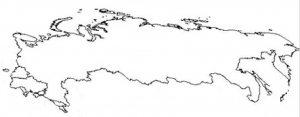102 Russian Domain: Overview
In the various essays about Russia in this textbook, there are many facts presented and many ways of life understood. After reading the textbook, students or other readers should know and understand many things about Russia. Also, as has been stated, it is not the point of this textbook to attempt to convey every possible bit of knowledge about Russia. However, there are certain basic facts about Russia that the reader should know, whether picked up in previous chapters or not.
In area, Russia is huge (map to left). Straddling the Eurasian landmass, Russia covers eleven time zones, stretching from the Baltic and Black Seas to the Sea of Okhotsk and the Pacific Ocean. This is not a new phenomenon, for once the Russians passed the Ural Mountains into Siberia, there were few people to stop the tsars, the Cossacks, and others from expanding the empire to the eastern shores of Asia.
Being huge, Russia has vast quantities of natural resources. Oil and natural gas pipelines extend from western Siberia to a variety of European countries. Much of Russia’s economy depends on resource exports. Russians are proud of their huge country and enjoy noting its singular features – Lake Baikal is the world’s deepest lake, Siberia has the world’s largest coniferous forest, the Trans-Siberian Railway is the world’s longest railroad, etc.
Physical Geography
Climates and Landforms
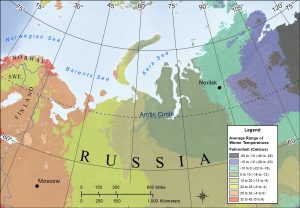
Cartography by Steve Wiertz
Northern European Russia, northern Ukraine, and all of Belarus and Moldova are dominated by the humid continental climate, featuring short, warm, wet summers, and long, very cold winters. This is similar to the climate of the U.S. Midwest and eastern and central Europe. This region’s winters, however, can be far colder. Moscow, for example, is not only very far from the moderating influences of the Atlantic Ocean, it is also located at a very high latitude. It is, in fact, nearly a thousand miles closer to the north pole than Chicago. Being parallel to Canada, of course Russia will have a relatively cold climate. With almost its entire coastline being on the frigid Arctic Ocean, Russia receives little warming from the sea. Being cold, Russia’s land often is inhospitable to sizeable human population. Indeed, Siberia averages about eight people per square mile. Although often cold, Russia is not simple one slab of ice. Being huge, Russia incorporates numerous landscape features. Yet, the tundra is cold. Tundra (тундра) is land that is sufficiently cold so that even trees are uncommon or absent. In fact, the term tundra, meaning treeless, is a word taken from the language of the Sami peoples who are native to these far northern lands. In Russia the tundra extends across the length of the Arctic coastline from the Kola Peninsula to the Bering Strait (Chapter 97), typically dipping 100-400 miles south of the northern ocean. Siberia is the vast eastern section of Russia. It possesses a mixture of humid continental, subarctic and arctic climates. Generally speaking, it is warmer in the south and colder in the north. But Siberia is best known for its temperature extremes. Buried deep in the world’s largest landmass, Siberia possesses the world’s ultimate continental climate. It is not uncommon for a Siberian city to reach temperatures in the 80s in the summertime, and then regularly reach 70 below in the depths of winter. One Siberian city, Verkhoyansk, has the distinction of having the greatest difference on earth between its record high temperature (+99˚F) and it record low (-90˚F).
You may recall the climate that dominates the much of the interior western United States is called a “steppe” climate. That climate draws its name from the vast, treeless plain, or steppe (степь), often present in southern European Russia and southern Ukraine (and Kazakhstan). This region features warm summers and cold winters, but is a semi-arid climate, with much less precipitation than the humid continental climate to its north. This accounts for the region’s characteristic lack of trees.

However, the dominant physical landscape of Russia is mainly coniferous forest, known there as taiga. Although the roots of the word тайга are Turkic, this is a vast Russian landscape. This too stretches the length of the country from Karelia bordering Finland to the Sea of Okhotsk. In contrast to the tundra, taiga lunges fully southward, so that in central Siberia is reaches Russia’s southern border there with Mongolia. While much of these forests is comprised of evergreen trees such as larch, there are some deciduous species present. For instance, Russian birch trees often are seen as emblematic of Russian forests. A majority of the land of the world’s largest country is taiga. There also are forests in western Russia; however, these show a much higher share of deciduous (broadleaf) trees than found in Siberia.
Although the Soviet Union had considerable desert area in Central Asia, by itself Russia has little desert or near-desert land, that being a small area along the borders with Kazakhstan and the Caspian Sea.
The landform patterns of the European part of the Russian Domain are very simple. Nearly all of it – Russia, Moldova, Ukraine, and Belarus – is dominated by the North European Plain. It is quite similar to the Midwest; sometimes flat, sometimes gently rolling, but always at low elevations.
The only exceptions are found in western Ukraine, which includes part of the Carpathian Mountains, and in Armenia and Georgia, which are home to the Caucasus Mountains. The Caucasus region contains very high peaks that run from the Black Sea to the Caspian Sea.
Siberia is bounded on the west by the Urals, a relatively low mountain range. The rest of Siberia is made up of four major physical zones. The Western Siberian Plain is very flat and swampy. To the east is the Central Siberian Plateau, a hilly region of dissected plateaus. The southern and far eastern edges of Siberia are dominated by highland areas, including the volcanic Kamchatka Peninsula. Finally, most of the northern rim of Siberia consists of the vast, flat Arctic Coastal Plain.
Because both Georgia and Armenia are very mountainous, and because they fall in the border region between midlatitude and subtropical zones, the climate patterns of those two countries are incredibly complex. They feature a mixture of Mediterranean, steppe, and humid subtropical climates, and contain hundreds of alpine microclimates. Generally speaking, both countries are generally drier in the west, and wetter in the east; temperatures are warmer at low elevations, and cooler at high elevations.
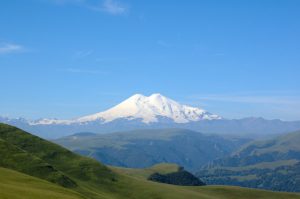
Photo by Konstantin Malanchev on Flickr.
The Soviet Union had significant mountainous areas in Central Asia and the Caucasus that again by itself Russia no longer holds. In this case, though, Russia has other mountain ranges. The Ural Mountains are somewhat similar to America’s Appalachian Mountains in low elevation, age, and raw material wealth. Some of the mountains of the Caucasus region extend into Russia past the trio of countries there – Armenia, Georgia, and Azerbaijan. This includes Mt. Elbrus, the highest mountain of Russia at 18510 feet. In Siberia, there are several mountain ranges. The Altai Mountains cross Russia’s southeastern border with Kazakhstan, as the Sayan Mountains do with China’s western border with Russia. East of Lake Baikal are the Yablonoi Mountains which sit south of the Stanovoy Range. Farther north and then east of the Lena River is the Verkhoyansk Range that lie west of the Kolyma Mountains that sit across from the Kamchatka Peninsula (Chapter 92) and its volcanoes.
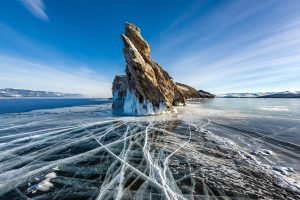
There are plenty of lakes in Russia, but by far the most noteworthy are Lake Baikal and the Caspian Sea. Lake Baikal is the world’s oldest and deepest lake, filling a mile down between stretches of mountains. The Caspian Sea technically is a lake, for it fails to connect to the world’s oceans, thus not meeting the geographic standards to be a sea. While the Soviet Union held about 3/4 of the shoreline and thus waters of the Caspian Sea (the rest for Iran), now Russia’s share is only about 1/4. In terms of waterways, the historic Volga River is crucial to western Russia, but is considerably smaller and shorter than Siberian streams that are noted in Chapter 85.
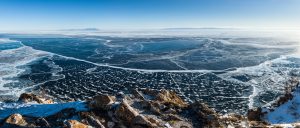
Even by random chance, we would expect that the vast lands of Russia would hold a variety of natural resources. This certainly is true, though the remote locations of many of these resources has presented challenges for the extraction and transportation of energy and mineral wealth. Siberia is a treasure trove of energy sites – oil and natural gas (Chapter 83) – and mineral resources – nickel, gold, platinum and more. In the 1930s Stalin had the city of Magnitogorsk constructed to specialize in the extraction and processing of immense deposits of iron ore nearby. Bordering Ukraine, the Kursk Magnetic Anamoly holds another huge supply of iron ore. The resource city of Norilsk is discussed in Chapter 88.
Historical Geography
Russia’s Land Empire
In the 1400s, Russia was a medium sized country situated on the North European Plain. At about the same time that other European countries, such as Spain, Portugal, France, and Britain, began to build their empires, Russia started to build one of its own. The major difference is that, while those other European empires were maritime empires – built by naval power and involving overseas colonies – the Russian Empire was a land empire. Between the 1500s and 1800s, Russia expanded across much of the eastern edge of the North European Plain, and then south and west across Asia. By the 1800s, Russia was Europe’s largest country, both in terms of land area and population, and it possessed vast amounts of natural resources. Still, standards of living in Russia were extremely low by European standards. Russia had not developed a thriving merchant class, as had many other European countries, and it was barely industrialized. The country’s wealth was largely in the hands of a small ruling class, with the vast majority of the population being poor, rural peasants. This left it ripe for revolution.
The Soviet Union
In 1917, as Russia was suffering badly in World War I, Tsar Nicholas II was overthrown, and numerous factions competed for control of Russia. Soon thereafter, communist revolutionaries known as the Bolsheviks managed to seize power. Vladimir Lenin, the first leader of Communist Russia, died in 1924. His successor was Joseph Stalin. Stalin would run the country until his death in 1953, and would largely responsible for shaping the modern version of communism, sometimes called Stalinism. The former Russian Empire adopted a new name – the Union of Soviet Socialist Republics – USSR (Союз Советских Социалистических Республик – CCCP). This Soviet Union with a communist government reorganized the internal geography of Russia, dividing it into seven, then twelve, and later fifteen, Soviet Socialist Republics.
This was largely a symbolic gesture. The country was administrated from Moscow, and the individual republics had little genuine power. It was likely done to make the country’s numerous non-Russian ethnic minorities feel like equal partners in the process. It is notable that Stalin himself was not ethnically Russian, but Georgian. He was born Ioseb Djugashvili (იოსებ სტალინი), and adopted the surname Stalin (which means “Man of Steel”) when he got involved in politics.
Stalin’s government developed the Soviet-style economy, in which the government seized control of all property and means of production. Everyone worked for the government, and everything was purchased from the government. Government bureaucrats determined what was produced, where it was produced, and how much was produced. They set all prices and wages.
Stalin’s thirty-year reign is remembered as period of extraordinary advances and extreme brutality. As for his successes, the material standard of living for Soviet citizens generally rose during Stalin’s reign. The Soviet Union developed effective research and education institutions. Industrial output skyrocketed. When Stalin assumed power, Russia was second-tier country in Europe, at best. When Stalin died, the Soviet Union was one of the world’s two great superpowers.
Stalin’s reign is also remembered for some substantial failures. First, the Soviet-style command economy would eventually stall, and was the primary reason for the Soviet Union’s ultimate collapse. Second, the Soviet Union’s environmental policy was practically non-existent, and the post-Soviet region remains one of the most toxic environments in the world. But Stalin is perhaps best remembered for his ruthless accumulation of political power. He repressed all forms of opposition. He developed the infamous Soviet secret police, which spied on the country’s citizens, often torturing and executing suspected dissidents. Large numbers of people were formally executed by Stalin’s government. The “lucky” ones were sent to gulags (prison work camps) in Siberia, where they were likely to die within a few years. In all, Stalin’s policies were responsible for the early deaths of millions of Soviet citizens. The exact number of excess deaths will never be known, but scholarly estimates range between 20 and 60 million.
The Collapse of the Soviet Union
In the 1980s, few Americans believed that the Cold War would end anytime soon. The idea that it would end in 1991 with the collapse of the Soviet Union was almost unimaginable. In hindsight, though, it is clear that the Soviet Union was experiencing a crisis for about a decade before it collapsed.
The beginning of the end came in Poland. Lech Walesa, an electrician working in a shipyard, formed a labor union known as Solidarity, and its members began to demand economic and political reform. Labor unions were illegal in Poland, and throughout the communist bloc. Previous demands for reform in the satellite states had been crushed, but neither the Polish nor the Soviet government was able to control Solidarity, and the Polish government was forced to give in to some of the workers’ demands. This success reverberated throughout the Soviet bloc and, throughout the 1980s, demands for reform in the satellite states, and eventually the Soviet Union itself, became more and more persistent.
The most significant problem facing the Soviet Union was economic. In the end, the Soviet economic system proved unsustainable. By the 1980s, productivity was declining, and goods were becoming scarce. Many who lived in the Soviet Union in the 1980s remember spending hours in line to buy even the most basic consumer goods.
Another problem facing the Soviet government was Afghanistan. The Soviets had invaded Afghanistan in 1979 to prop up an unpopular communist regime there. The Soviets did not expect their troops to be there for more than a few months, and yet the war dragged on for ten years. This is largely because they encountered a highly motivated Islamist resistance movement, funded by the United States, known as the Mujahideen. (Unfortunately for the United States, the Mujahideen would later be the genesis of both al-Qaeda and the Taliban, which the U.S. has spent the last twenty years battling in Afghanistan and other countries).
It is an enormous overstatement to say that the war in Afghanistan brought down the Soviet Union – the economy did that – but the mounting casualties in that war severely drained the morale of Soviet citizens. It might be described as the proverbial straw that broke the camel’s back.

In 1985, Mikhail Gorbachev became the new leader of the Soviet Union, and he would be its last. Responding to growing social unrest, Gorbachev instituted two important reforms. The first was known as perestroika. This involved the decentralization of economic decision-making and the infusion of some market elements into the communist economy. The second was known as glasnost. This was the opening of public debate. For sixty years, criticizing the government in the Soviet Union had been a deadly proposition. Now, Soviet citizens were free to speak their minds. Many scholars believe that if Gorbachev’s reforms had come a decade earlier, they may have saved the Soviet Union. But it was too late. The communist economy was beyond rescue, and the long-silenced resentment of Soviet citizens boiled over into mass protests.
In 1989, the satellite states were breaking free from Soviet control. In 1990, leaders in the Latvian, Lithuanian, and Estonian Republics were openly calling for independence from the Soviet Union. In August, 1991, a brief, unsuccessful military coup sent the Soviet Union into chaos. On December 21st, representatives from the Soviet Republics agreed to officially dissolve the union. On Christmas Day, 1991, Mikhail Gorbachev resigned, declaring his office “extinct.” That night, the Soviet flag was lowered from the Kremlin, and the Russian national flag was raised in its place. Again. to be clear, Russia is not and was not the same place as the Soviet Union (USSR). Under the tsars, the Russian Empire expanded greatly, especially across Siberia. The land area of the Russian Revolution that overthrew the Romanov dynasty was roughly the same as the extent of the Soviet Union after World War II. Russia was by far the largest piece of the Soviet Union, both in population and in area; however, there were numerous other pieces too. When the Soviet Union dissolved in 1991, Russia became an independent country, but the other fourteen republics of the USSR did so as well. This geopolitical event distributed a lot of land and a large number of people from the USSR into these new countries. So, Russia is huge in area and big in population, but it is smaller than the Soviet Union was. During the decades of the Soviet Union and ever since then Russia has faced demographic challenges that eventually resulted in Russia having several recent years of more deaths than births. Most population scholars anticipate that Russia’s population will shrink in upcoming years and decades.
The breakup of the Soviet Union led to great disruption within the fifteen successor States. Russia experienced considerable social, economic, and political turmoil. The country’s eventual relative stability under the leadership of President Vladimir Putin is responsible for much of his popularity. Putin’s emphasis on pushing Russia’s international status and clout toward that of the Soviet Union also has been effective in boosting his appeal. Russia annexed Crimea from neighboring Ukraine in 2014 and continues to battle in eastern Ukraine.
Even so, the chaos following the dissolution of the USSR led to great economic disparities and the development of the super-rich oligarch class (Chapter 90). Moscow ranks fourth in the world among cities with numbers of billionaires. In 2019 Credit Suisse Bank in Switzerland ranked Russia as the world’s most unequal economy with the top 10% of people owning 83% of Russia wealth.
Russia has inherited many elements of life from the Soviet days. The skewed sex ratio (Chapter 94), heavily favoring numbers of women, is an artifact of male life expectancy in the late Soviet period. Considerable environmental pollution is a legacy of Soviet near total disregard for protecting the natural environment. The ethnoterritorial system (Chapter 86) of managing a multinational State moved from the Soviet Union to the governing system of Russia. The autocratic leadership under Putin is a morphed inheritance of the authoritarian Soviet system, which in its harsh control was an altered version of tsarist autocratic rule.
Although World War II is even further back in history than is the breakup of the Soviet Union, WWII still is noteworthy for Russians. At a bare minimum there were twenty million deaths on the Soviet side. The Battle of Stalingrad caused 3.5 million Soviet deaths alone. While the Stalin era also cost millions of lives as caused by the communist system, unlike the history of WWII, Stalinist history has not been taught well in Russian schools. In fact, in a survey by the Levada-Center in 2019, when asked what role Stalin played in the history of Russia, 70% of answering adults in Russia either said entirely positive or mostly positive. It should not be a surprise that Putin seems to secure the highest ratings of popularity when he emphasizes nationalism, even as far as annexing Crimea away from Ukraine.
Political Geography
Democracy
Sometimes referred to as “Europe’s last remaining dictatorship,” Belarus has the dubious distinction of being Europe’s most authoritarian country. It is a nominal democracy, holding the occasional sham election, but it has been dominated by one political party since independence, and that party has suppressed, sometimes violently, all criticism and opposition. Following evidence of fraud in the August 2020 re-election of President Lukashenko, unprecedented protests have broken out in Belarus, including those of 100,000 people in the capital city Minsk.
Ukraine, Moldova, Georgia, and Armenia are best-labeled as “partial democracies.” All have held multi-party elections in recent years. But they’ve also had recent histories of political violence and rampant corruption. For many years, Russia has also been described as a partial democracy. It does have democratic institutions and elections. Increasingly, though, calling Russia even a “partial” democracy is a bit of stretch. The country has been ruled by Vladimir Putin for two decades, and his United Russia party has such a large majority in parliament that Putin can effectively rule by decree. Remember reading about Putin in Chapter 93. Throughout Putin’s time in office, democracy has eroded in Russia. Elections have become suspect, and scores of key opposition leaders have been jailed or murdered. Crackdowns on the press have effectively silenced most public criticism of Putin.
Putin and Russian Re-Expansion
When the Russian-dominated Soviet Union collapsed in 1991, not only did Russia lose control of its numerous satellite states in eastern Europe, but it also lost control of significant swaths of territory that had long been part of the Russian Empire. Fourteen independent countries now occupied more than two million squares of former Russian territory. Since Vladimir Putin ascended to the Russian presidency in 2000, he has developed a geopolitical strategy to reassert Russian control over territory it lost nine years before.

Before he could do that, however, Putin had to guarantee that Russia didn’t lose any additional territory. About 29 million people – 20% of Russia’s population – are not ethnically Russian. So far, only one non-Russian group has made a serious attempt at independence. Chechnya, a small enclave in the Caucasus mountains is home to the Chechens, an ethnic minority numbering about a million. In 1991, with the collapse of the Soviet Union, Chechnya declared independence from Russia, and remained a de facto independent state for nearly a decade. When Vladimir Putin came to power, one of his first acts was to unleash a furious military assault on Chechnya, effectively ending that country’s independence. Defeating the Chechen rebels accomplished a few important geopolitical goals for Russia. First, it reasserted Russian control over the strategically important Caucasus region, which we’ll discuss in a bit. Second, it helped protect vital routes for pipelines carrying oil from the Caspian Sea to the Black Sea. Third, and most important, it sent a signal to all other potential separatist regions in Russia that the Putin government would not tolerate the further loss of Russian territory.
One of Putin’s primary goals outside of Russia’s borders has been to aggressively contain the expansion of NATO and the European Union. From the Russian viewpoint, NATO is a club full of traditional Russian enemies, notably Germany, Turkey, Britain, France, and the United States. Many Soviet leaders were convinced that NATO’s ultimate goal was an invasion of the Soviet Union.
When the Soviet Union collapsed, many wondered if NATO would be dissolved. It was decided, however, that it could serve as a vital peacekeeping force for Europe, and many countries were interested in maintaining a close military alliance with the United States. Among them were eastern European countries looking to the United States for protection from Russian re-expansion. By 2004, NATO included all of the Soviet Union’s former satellite states, and three former members of the Soviet Union itself – Latvia, Lithuania, and Estonia.
This eastward expansion of NATO was scarcely noticed by most Americans, but it caused alarm in Russia. In 1989, the closest NATO military base to St. Petersburg was a thousand miles away in West Germany. Twenty years later, it was only seventy miles away, in Estonia. Many Russians see NATO’s expansion as, at best, an attempt to marginalize Russia and, at worst, a prelude to an invasion of Russia.
The European Union is also viewed by Russia as an existential threat. A unified Europe, which would form the world’s largest economy and a contain a population of more than a half-billion people, further threatened to marginalize Russia as it expanded into Russia’s traditional economic domain. Like NATO, the EU would eventually include all of the former eastern satellite states and the Baltic states.
To make matters worse for Russia, the EU invited a few other former Soviet republics to join the Eastern Partners Program. This program would not constitute full membership in the EU, but it would create a free trade zone that encouraged these countries to trade more with the EU and, more than likely, trade less with Russia.
Since coming to power, Putin has launched an aggressive campaign to contain and destabilize NATO and the European Union. Russia combated the Eastern Partners Program by threatening potential members. One example was Moldova. When Moldova announced plans to join the program, Russia immediately banned the sale of Moldovan wine and produce in Russia, which had been Moldova’s largest market. Although it was cited as a food safety measure, it was clearly punishment for Moldova aligning with the EU.
Another example of a Russian attempt to undermine the European Union can be found in Syria. That country devolved into a civil war in 2011. It turned into a complex multi-front conflict. Most EU countries, along with the United States, backed moderate rebels opposed to the government of Bashar al-Assad. At first, Russia gave only modest support to Assad. As refugees began to pour out of Syria and into Europe, the influx created disputes among EU members about how to handle the tide of migrants. Realizing that this was such a divisive issue, Putin stepped up an aerial bombing campaign in Syria. The more bombs Russia dropped on Syria, the more refugees departed for Europe, and the greater the discord among EU members.
A final example of Russian attempts to undermine NATO and the EU can be found in its covert efforts to help bring anti-NATO and anti-EU politicians and political parties to power in Europe and the United States. Russian agents have used both financial resources and, more effectively, a mass campaign to spread information (and, just as often, disinformation) on social media that promotes such political parties. Many of them are nationalist parties that deeply oppose European integration, and Russia’s media campaign has promoted them by spreading anti-immigrant propaganda. Russia’s greatest successes in this regard might be Brexit and the election of President Donald Trump. While neither of these events were entirely the result of Russian influence, Russian meddling definitely played a significant role in both. President Trump has repeatedly questioned America’s commitment to NATO, occasionally speculating about the U.S. leaving the military alliance entirely (which would be a massive coup for Russia). As president, Trump has had a much friendlier relationship with Putin than with the leaders of the European Union. Brexit is even more significant. Britain was one of the EU’s largest economies, and its departure will certainly weaken the bloc.
Another Putin priority is reasserting Russian control over the Caucasus Mountains. Acquired in the 1800s, the Caucasus were prized by Russia as a natural wall protecting it from invasion from southwest Asia. In 1991, when George, Armenia, and Azerbaijan gained their independence, Russia lost control of much of the Caucasus region. One example of Russia’s efforts to control the Caucasus was the Chechen War, discussed above. Another was the 2008 conflict with Georgia. Remember reading about Georgia in Chapter 86.
Perhaps Putin’s greatest priority is to increase Russia’s influence in all the countries that used to be part of the Russian Empire and the Soviet Union. One way he has done this is through economic incentives. The most significant is the Eurasian Union, a Russian-dominated economic alternative to the European Union. Like the European Union, the Eurasian Union is built on the promise of free trade, the free movement of labor, and a unified currency. In 2000, Putin called upon all former Soviet Republics to join the union. Putin made it clear that he was not trying to reassemble the Soviet Union, although that is, of course, precisely what he is trying to do. Membership is tempting for some former Soviet republics – it provides these relatively small countries access to the large Russian market and billions of dollars in Russian investments. Membership is also troubling for some of these countries. Finally independent after years of Russian rule, joining the union strikes some as a loss of sovereignty. So far, only four former Soviet republics have joined the Eurasian Union: Belarus, Kazakhstan, Armenia, and Kyrgyzstan.
Another way to increase Russian influence in former Soviet republics is through economic coercion. Russia is the largest trading partner of most of the former Soviet republics, and it has the ability to launch punitive economic measures against these countries if they “misbehave.” Perhaps Russia’s greatest advantage over these countries is energy. Nearly all of them get most of their oil and natural gas from Russian pipelines, giving Russia the ability to cripple their economies by shutting off their access to these resources.
Russia can also increase its influence over former Soviet republics by empowering the Russian minorities that live there. This is especially true of four countries where ethnic Russians make up significant portions of the population. Russians account for about 25% of the population in both Latvia and Estonia, about 20% of Kazakhstan’s population, and about 17% of Ukraine’s population. These Russians are, of course, likely to support political parties that are pro-Russian, and Russia can further empower them by striking favorable business contracts with them.
A final way that Russia can increase its influence over former Soviet Republics is the most blunt – through military force, as done in Ukraine. The political situation in Ukraine is complex, but, put simply, the biggest political dilemma for that country since 1991 has been its orientation toward, or away from, Russia. Pro-western political parties in Ukraine want the country to orient itself toward the west, by doing such things as joining NATO and the European Union. Pro-Russian political parties in Ukraine want to maintain close economic and political ties with Moscow. These feuding political blocs have traded power multiple times in Ukraine. Ethnic Russians, concentrated in eastern and southern Ukraine tend to, of course, support pro-Russian candidates. Ethnic Ukrainians, who make up the majority of the population are divided. Many are ardently anti-Russian. Others view close ties with Russia as being pragmatic.
In 2010, a pro-Russian government was narrowly elected. Accusations of corruption against this government fueled mounting protests that, by 2014, had escalated into a full-scale revolution. Viktor Yanukovych, the pro-Russian president, was forced to flee the country, and a pro-western government was installed.
The Russian government, and many Russians living in Ukraine, considered this to be an illegal coup. This resulted in two major military actions. The first was Russia’s seizure of Crimea, a peninsula in southeastern Ukraine (as included in the outline map above). Crimea has long been demographically dominated by ethnic Russians, and it is of tremendous military and economic significance, given its position on the Black Sea. In a hastily called 2014 referendum, voters in Crimea chose to secede from Ukraine and join Russia. The peninsula was immediately occupied by thousands of armed Russian “volunteers.” Their uniforms carried no insignia patches and their vehicles were unmarked, but they were clearly members of the Russian military, ordered by Putin to seize Crimea.
The international community largely condemned this action, and few countries recognize Russia’s territorial claims in Crimea. A second military action that began in 2014 was a separatist rebellion in eastern Ukraine. In this overwhelmingly Russian area of Ukraine, conflict has erupted sporadically over the last six years between the Ukrainian military and separatists who would like Ukraine’s far east to secede and join Russia. Unlike the military action in Crimea, these separatists actually do appear to be “volunteer” revolutionaries, although there is much evidence that they are being supported with military aid from Russia.
Economic Geography
Development
Compared to much of the rest of the world, the Russian Doman is a relatively wealthy region. Compared to European Union, however, it is not. Russia’s HDI rates its standard of living above only two members of the EU—Romanian and Bulgaria. The remaining Russian Domain countries—Ukraine, Belarus, Georgia, Armenia, and Moldova—have an HDI that ranks below all countries in the EU.
The Soviet Economy
From the time of the Bolshevik revolution in 1917 to the collapse of the Soviet Union in 1991, the Russian Domain was guided by communist economic ideals. A communist economy is sometimes also called a “command economy.” To get a sense of communism, it is handy to compare it to capitalism, which is sometimes called a “free market” economy.
Think about our College of DuPage. It is a community college. So, who owns the college? The community does. We all own it. Since the government is the representative of the people, it administers the college for us. In a capitalist economy, many things – colleges, libraries, parks, military bases, highways – are community property, owned by all of us, and administered by the government.
In a capitalist economy, however, most property is private property, owned by individuals or corporations. Businesses, farms, residences, factories, office buildings, and the like, are usually private enterprises. You have your house, I have mine. You have your business, I have mine.
In a communist economy, everything is owned by everyone. Not just colleges, libraries, and parks, etc., but everything. Steel mills, factories, farms, department stores, barber shops, grocery stores, tea shops, pharmacies, apartment buildings, gas stations, mines, office buildings, and everything else, is owned by everyone. That’s what communism refers to. Everything is communally owned. And since the government (theoretically) represents the people, the government administers everything.
A capitalist economy is effectively governed by the forces of supply and demand. If enough people want (demand) something, a company will supply it. If it’s in high demand, more will be produced. If it’s in low demand, less will be produced. Supply and demand also govern wages. If your skills are in high demand, you’ll likely earn higher wages. If your skills are in low demand, you’ll likely earn lower wages. The same is true of prices. If something is scarce, the price will go up. If something is plentiful, the price will go down. Of course, governments do a lot of things that effect the economy – taxes, spending, infrastructure, as well as labor, environmental, trade, and financial regulations – but largely the economy is driven by the forces of supply and demand in the free market.
A communist economy is not governed by the forces of supply and demand. It’s controlled entirely by the government (hence the term “command economy”). Production is dictated by government bureaucrats, who determine what is produced, how much is produced, and where it’s produced. Since everyone works for the government, the government determines all wages. And since everything is owned by the government, the government determines all prices.
Think back to Chapter 56, where we analyzed communism vs. capitalism.
Russia’s Economic Shock Therapy
Russia made its transition from communism to capitalism practically overnight. Dubbed “economic shock therapy” by the first post-Soviet president of Russia, Boris Yeltsin, this move proved disastrous.
Russia began to sell off many of its state-owned assets to private companies and individuals, many at secretive “midnight auctions” orchestrated by corrupt officials. This enabled a handful of people to gobble up huge chunks of the Russian economy, forming the “oligarch” class – a small group of extremely wealthy people. Central planning was lifted – all production, wages, and prices were left to the whims of the free market.
Immediately, unemployment skyrocketed. To boost efficiency, the newly privatized companies of Russia began laying workers off by the millions. Because the government no longer oversaw every element of the economy and society, millions of government employees were laid off as well. Worse, inflation rates – an index of the average cost of living – exploded upward.
Consumer goods were always scarce in the Soviet Union. Prices, however, were controlled by the government. So, even if you had to wait weeks to obtain something, it would still be affordable once you got it. With price controls lifted, the law of supply and demand took over. When the supply of something was scarce, the price shot upward.
To make matters worse, Russia had moved to a private economy before developing a coherent tax collection system. The communist system hadn’t had taxes, since everything was already owned by the government. The Russian government was suddenly unable to pay its bills. So, to make up the difference, the Russian government began printing more money. Unfortunately, money operates according to the same laws of economics as everything else. If the supply goes up, the value goes down. By overprinting money, the Russian government destroyed the value of its currency.
As a result, everything became much more expensive just as money was becoming worthless. Russia’s annual inflation rate in 1992 was 2509%, a disastrous number. (In the United States, an annual inflation rate above 5% is considered unhealthy). Russians were digging into many years’ worth of savings to buy a week’s worth of groceries.
The 1990s were generally disastrous for Russia, and for many of the other countries in the Russian Domain. Gross domestic product (GDP) declined by 50% over the course of the decade. For comparison, the United States’ GDP declined by about 25% during the Great Depression.
Even so, the chaos following the dissolution of the USSR led to great economic disparities and the development of the super-rich oligarch class (Chapter 90). Moscow ranks fourth in the world among cities with numbers of billionaires. In 2019 Credit Suisse Bank in Switzerland ranked Russia as the world’s most unequal economy with the top 10% of people owning 83% of Russia wealth.
Russia’s Economic Recovery and Subsequent Recession
In the 2000s, the Russian economy entered a period of recovery. Average incomes grew by about 10% annually, and unemployment and poverty rates declined. The main source of economic growth was energy. Russia possesses 6% of the world’s oil, and 27% of its natural gas. Once mechanisms were in place to export these commodities to areas outside of the old Soviet bloc, energy revenues climbed. Energy currently accounts for about 67% of Russia’s export earnings.
The problem with the energy industry is that it is not particularly labor intensive. It generates enormous wealth for stakeholders in the industry, and plenty of “echo” jobs in sectors like consumer services, real estate, and finance. But this new economy hasn’t expanded a lot of traditionally middle-class occupations, like manufacturing. It also makes Russia very vulnerable to the whims of an unstable market.
In 2015, Russia’s economy experienced a significant downturn, and has not fully recovered. While the situation is still a far cry from the economic disasters of the 1990s, it’s also perhaps a sign that the rapid growth of the 2000s might not be sustainable.
Economic sanctions placed on Russia by many western countries as punishment for its actions in Syria and Ukraine are partly to blame, but downward trends in the Russian economy appear to be tied mostly to downward trends in the price of oil. When oil prices go up, Russia does well. When they sink, Russia is in trouble. In April of 2011, the price for a barrel of oil was $116, and the Russian economy was soaring. By January of 2016, it had plummeted to $34 per barrel, and the Russian economy was in recession. By October of 2018, oil had inched back up to $71 per barrel, and the Russian economy showed some improvement. In 2020, a price war with Saudi Arabia, coupled with the coronavirus pandemic, sent oil all the way back down to $28 per barrel. This is likely to have severe repercussions for the Russian economy.
Cultural Geography
Direct Link to Video (New Tab)
Religion
Eastern Orthodox Christianity is the dominant religion in Russia, Ukraine, Belarus, Moldova, and Georgia. Recall reading about the Russian Orthodox Church in Chapter 89. Most Armenians identify with the Armenian Apostolic Church, a separate branch of Christianity that predates both the Eastern Orthodox and Roman Catholic Churches. Islam is the largest minority religion in the region, particularly in Russia (where about 15% of the population is Muslim), and Georgia (10% Muslim). Although religious identity remains important in the Russian Domain, active participation in religion has declined. For example, about 80% of Russians identify as Christian, but only 15% regularly participate in worship services.
Language
Most people of the Russian Domain speak Indo-European languages. Russian, Ukrainian, and Belarusian are Slavic languages. Moldovan is a Romance language, and is mutually intelligible with Romanian. Armenian is the only member of its subfamily of the Indo-European family. A significant minority in the Russian Domain speak languages form the Turkic language family, particularly those who live in the Caucasus Mountains and in Siberia. A third language family is found in Georgia. The Kartvelian language family includes Georgian, and three small related languages, found mainly in the Caucasus region.
Ethnicity
All of the countries of the Russian Doman are dominated by their nominal nationality. Armenia is the most homogenous, with 98% of the country being Armenian. Other countries are slightly less homogeneous– Georgia (87%), Belarus (84%), Ukraine (78%), Moldova (78%). Russia is 78% Russian, but has dozens of smaller ethnic groups across its vast land, making it a multinational state.
Many of the ethnic minorities in this region come from other nations of the Russian Domain. Russians are a significant minority in Ukraine, Belarus, and Moldova, as are Armenians in Georgia, Ukrainians in Moldova and Russia, and Belarusians and Moldovans in Ukraine. There are also some minorities from the former Soviet bloc in eastern Europe, like Romanians and Bulgarians in Moldova, and Poles in Belarus.
Other major ethnic minorities include Kurds, Azeris, Tatars, Gagauz, Bashkir, Chuvash, and Chechens. These groups are among the many whose homelands were absorbed as the Russian Empire expanded. Russia officially recognizes 160 different minority groups within its borders. Some of these groups are Christian, and some Muslim. Some are Turkic, historically related to the Turks and the peoples of Central Asian nations like Kazakhstan and Uzbekistan.
Population Geography
The Russian Doman has a total population of 211 million, with Russia (147 million) accounting for 70% of that population. Ukraine (43 million) accounts for another 20%. The remaining four countries collectively account for about 10%, including Belarus (10 million), Moldova (9 million), Georgia (4 million), and Armenia (3 million).
Like Europe, all of the countries of the Russian Domain have TFRs well below replacement rate. The countries of the Russian Doman are far into the Demographic Transition, generally with more deaths than births and featuring well-educated, highly urbanized populations. Additionally, the somewhat dim economic prospects for many has further discouraged people from starting families.
Russians comprise a remarkable nation, locked into a huge and often cold land, governed by autocratic leadership. For this textbook, we are counting Ukraine, Belarus, Armenia, Georgia, and perhaps Moldova in a region to be called the Russian Domain. The peoples of Ukraine and Belarus are mainly Slavic, sharing ethnic and linguistic characteristics with Russians. The lands of Ukraine and Belarus border western Russia and not surprisingly share similar landscape features of forests and the North European Plain. These several lands that now are the countries listed here share historical links with Russia, territorial occupation and conquest both in the tsarist era and during the Soviet Union. The Russian Domain is mapped to the left.
Did You Know?

The steppe eagle breeds in Siberia and Kazakhstan. In 2019 a tagged steppe eagle send accumulated GPS data back to scientists in Russia. Unfortunately, the eagle had flown to Iran, so that when the data was sent, it accumulated huge roaming charges.
The Siberian tiger does live in the taiga.
Check Your Understanding
Cited and additional bibliography:
Berezedy, Bence. n.d. Soviet Union Map by Bence Bezeredy from the Noun Project. Accessed October 15, 2020. https://thenounproject.com/search/?q=Soviet+Union&i=1441466.
Bulyankova, Tatiana. 2014. Sable Home. https://tinyurl.com/sabletaiga. Attribution-ShareAlike 2.0 Generic (CC BY-SA 2.0).
Comrie, Tyler. n.d. Hammer and Sickle by T Com from the Noun Project. Accessed June 10, 2020. https://thenounproject.com/search/?q=soviet%20flag&i=58179.
Frank, Robert. 2018. “The 10 Cities with the Most Billionaires.” CNBC. May 17, 2018. https://www.cnbc.com/2018/05/17/the-10-cities-with-the-most-billionaires.html.
Gilliland, Clay. 2018. Haja Aymani Kadyrova Mosque in Argun, Chechnya. https://tinyurl.com/chechnyamosque. https://creativecommons.org/licenses/by-sa/2.0/.
Malanchev, Konstantin. 2010. Elbrus. https://tinyurl.com/elbrusmt. Attribution 2.0 Generic (CC BY 2.0).
osipov, valeriy. 2010. Gorbachev. https://tinyurl.com/mgorbachev. Attribution 2.0 Generic (CC BY 2.0).
Pesterev, Sergey. 2016a. Lake Baikal. https://tinyurl.com/baikallake. Attribution-ShareAlike 2.0 Generic (CC BY-SA 2.0).
“Stalin’s Perception.” 2019. Levada-Center. April 19, 2019. http://www.levada.ru/2019/04/19/dynamic-of-stalin-s-perception.
Times, The Moscow. 2019. “Russia Named World’s Most Unequal Economy.” The Moscow Times. October 22, 2019. https://themoscowtimes.com/2019/10/22/russia-named-worlds-most-unequal-economy-a67836.
Veronesi, Francesco. 2013. Steppe Eagle. https://tinyurl.com/steppeeagle. Attribution-ShareAlike 2.0 Generic (CC BY-SA 2.0).
Wiertz, Steve. 2020. “Cold in Northwest Russia.” College of DuPage GIS class. Instructor Joseph Adduci.







